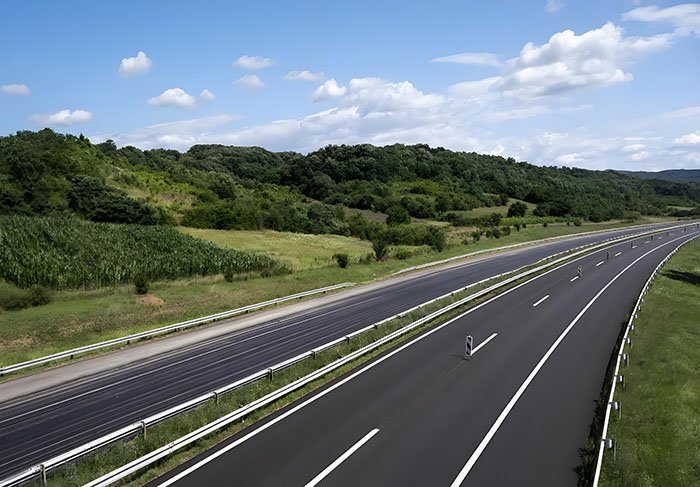The classification and standard requirements of highways are usually determined based on factors such as design speed, number of lanes, and traffic volume. The following are the grades and standard requirements for highways:
1. Design speed
Highway level: Divided into different levels based on design speed, usually including 120 km/h, 100 km/h, 80 km/h, etc.
Standard requirements:
120 km/h: Suitable for plains and hilly areas, with high linear standards and large curve radii.
100 km/h: Suitable for hilly areas, with high linearity standards and large curve radii.
80 km/h: Suitable for mountainous areas, with relatively low linearity standards and small curve radii.
2. Number of lanes
Highway level: Divided into four lanes in both directions, six lanes in both directions, eight lanes in both directions, etc. based on the number of lanes.
Standard requirements:
Two way four lane road: suitable for road sections with low traffic volume, with a width of generally 3.75 meters per lane.
Two way six lane road: suitable for road sections with high traffic volume, with a width of generally 3.75 meters per lane.
Two way eight lane road: suitable for road sections with high traffic volume, with a width of generally 3.75 meters per lane.
3. Roadbed width
Highway grade: The roadbed width is determined based on the design speed and number of lanes.
Standard requirements:
120 km/h, two-way four lane road: The roadbed width is generally 28 meters.
100 km/h, two-way four lane road: The roadbed width is generally 26 meters.
80 km/h, two-way four lane road: The roadbed width is generally 24.5 meters.
For every two additional lanes, the roadbed width increases accordingly.
4. Horizontal curve radius
Highway grade: Determine the radius of the horizontal curve based on the design speed.
Standard requirements:
120 km/h: The minimum radius of a horizontal curve is generally 1000 meters.
100 km/h: The minimum radius of a horizontal curve is generally 700 meters.
80 km/h: The minimum radius of a horizontal curve is generally 400 meters.
5. Longitudinal slope
Highway grade: Determine the maximum longitudinal slope based on the design speed.
Standard requirements:
120 km/h: The maximum longitudinal slope is generally 3%.
100 km/h: The maximum longitudinal slope is generally 4%.
80 km/h: The maximum longitudinal slope is generally 5%.
6. Sight distance
Highway level: Determine parking sight distance and overtaking sight distance based on design speed.
Standard requirements:
120 km/h: The parking line of sight is generally 210 meters, and the overtaking line of sight is generally 550 meters.
100 km/h: The parking line of sight is generally 160 meters, and the overtaking line of sight is generally 350 meters.
80 km/h: The parking line of sight is generally 110 meters, and the overtaking line of sight is generally 250 meters.
7. Road surface structure
Highway grade: The pavement structure is determined based on traffic volume and design speed.
Standard requirements:
Surface layer: usually made of asphalt concrete or cement concrete, with a thickness of 10-20 centimeters.
Base layer: Cement stabilized crushed stone or asphalt stabilized crushed stone is usually used, with a thickness of 20-40 centimeters.
Subbase layer: usually made of crushed stone or gravel, with a thickness of 15-30 centimeters.
Roadbed: The compaction degree meets the design requirements, usually not less than 95%.
8. Ancillary facilities
Highway level: All levels of highways must be equipped with complete ancillary facilities.
Standard requirements:
Guardrail: meets the requirements of anti-collision level and usually passes collision testing.
Markings: Clear, durable, and meet reflective requirements.
Logo: Conspicuous, easily recognizable, meets size and reflective requirements.
Lighting: Provide sufficient lighting intensity to ensure safe driving at night.
Drainage system: effectively eliminates accumulated water on the road surface and roadbed to prevent water damage.
9. Environment and Greening
Highway level: All levels of highways must consider the environment and greenery.
Standard requirements:
Green belt: The width and vegetation types meet the design requirements, providing good visual effects and ecological functions.
Soundproofing wall: The height and material meet the design requirements, effectively reducing noise.
Environmental protection facilities, such as sewage treatment facilities, garbage collection facilities, etc., comply with environmental standards.
10. Summary
The level and standard requirements of highways cover aspects such as design speed, number of lanes, roadbed width, horizontal curve radius, longitudinal slope, sight distance, pavement structure, ancillary facilities, and environment and greening. Different levels of highways have different standard requirements, and the design and construction process must strictly follow relevant standards and specifications to ensure the safety, durability, and comfort of the highway.


